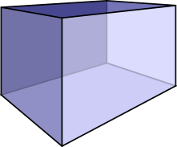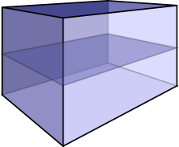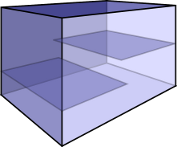CageCalc 2: enclosure calculation for small animals
Documentation
CageCalc 2 is a tool for calculating the needed enclosure size for small animals. It is different from other software in that it takes into account both the volume and the area of an enclosure (exceptions: guinea pigs and rabbits).
CageCalc 2 offers three modes:
- a simple mode for calculating "flat" habitats (i.e., for guinea pigs or rabbits) and simple cages with full-size shelves (i.e., for rats and mice),
- an advanced mode for enclosures that feature additional levels of different sizes,
- and a mode for calculation of the minimal enclosure size for a group of a given size.
Introduction: why CageCalc?
Animal welfare
Keeping animals as pets is demanding. Since the critter is essentially at it owner's mercy, the responsibility is very great. Unfortunately, animals (especially smaller rodents like mice or guinea pigs) are still bought by well-meaning (but ill-informed) parents for their children, meaning that a lot of pets are kept under precarious conditions: cages and enclosures that are way too small, social animals kept alone, and constant stress caused by loud (and sometimes rough) small children. Another problem is that animal dealers are first of all interested in selling the animal and not necessarily (certainly not primarily!) in its wellbeing.
CageCalc tries to give "honest" advice concerning enclosure size. This includes taking into account expert advice and reports as well as current European law on recommended conditions for the different species. This can mean that, as a result, CageCalc might tell you something radically different than the friendly clerk at your dealer's. In this case please seriously consider enhancing your enclosure. Another problem is social animals being kept alone. CageCalc will never recommend this. In fact, it is one of the cruelest things you can do to e.g. a rabbit or guinea pig, so please: don't.
History of CageCalc
CageCalc's existence has a simple reason: when trying to decide on a fitting habitat for a small pack of fancy rats, I found all available calculation aids to be deficient. They either did not take ground area into account, or nothing else. Rats are a prime example of an animal that is usually kept in a cage. However, the enclosure needs to fulfill minimal conditions both concerning its outer size and the "inner area" it provides.
From a simple "cage calculator" (hence its name) for rats and mice CageCalc has come quite some way. Since the calculation method can be used for different enclosure types, it now also allows calculating habitats of gerbils, guinea pigs and even rabbits. The latter two are calculated in a special "area only" mode, since here the inner area of a habitat is the single most important value (i.e., height is a secondary consideration).
The simple mode



In this mode you just provide the outer dimensions of the enclosure. For "flat" habitats (i.e., rabbits or guinea pigs) this means just the width and depth. For classical multi-level cages you also have to provide the height of the enclosure as well as the number of "shelves". Since the ground level already counts as one, e.g. a two-part module system has one additional shelf (thus the value to be entered would be "1").
The simple mode is available for nearly all animal types (exception: gerbils, where it makes no sense).The advanced mode


The advanced mode allows you to specify enclosures with multiple levels of different sizes. For gerbils, this is the only calculation mode available (since the simple mode makes no sense there). In this mode, you provide the outer dimensions of the enclosure as well as the height of the lowest level (i.e., the amount of space that the critters have above the ground floor). For every additional level you also provide its size and height (i.e., the distance to the next level or to the top). In "area only" mode (i.e., guinea pigs, rabbits) the height specification is of course omitted.
A shelf which is so low that the animals can not straighten up properly will be ignored during the calculation. The same goes for very small shelves (which should be considered rather a part of a ramp or ladder). Note: ramps, stairs, ladders etc. are never taken into acccount when calculating the necessary inner area of an enclosure.
Calculating the minimal size of an enclosure
Before buying a group of animals one should always consider where to keep them, and how. For example, if I am planning to buy four guinea pigs, I need to know how much space they are going to need.
The single information you have to provide in this mode is the number of critters. CageCalc then calculates the necessary inner area (and volume if needed) of an adequate enclosure. An example size is also calculated. This size is of course not the only possibility but is rather supposed to give you a better idea how large the enclosure will be.
Minimal dimensions
A rather frequently asked question is about minimal dimensions. People complain that they have entered the minimal width, depth and height given by CageCalc at the bottom of the page, and it still rejects the enclosure as being too small. The software is in fact correct in those cases, as a set of minimal dimensions combined does not necessarily make a minimal size. In this section, I will try to explain why.
The minimal values for width, depth and height of the enclosure are constraints that have to be met in addition to the volume and inner area of the enclosure being large enough. In other words, usually you can choose between suitable enclosures of different proportions. For example, a minimal width of 1 metre just states 'whatever enclosure you are considering, it has to be at least 1 metre wide'. However, this is not the same as '1 metre is always enough'. Since volume and area are considered independently, you have to take all dimensions together to see if they really are sufficient. This also means that even an enclosure meeting all other constraints (i.e., concerning its outer dimensions) can still be too small.
For example, a single pair of guinea pigs needs an enclosure providing an inner area of at least 1.5 square metres. In addition to that, the constraints exist that the width shall not be less than 1.5 and the depth not less than 0.8 metres. However, a size of 1.5x0.8 metres only yields an area of a little more than one square metre, meaning that it is insufficient for two guinea pigs. What is actually meant by these minimal dimensions is that both 1.9x0.8 and 1.5x1.0 metres are okay, so you can achieve the necessary size by extending either (or both) the width or the depth beyond their minimal values.